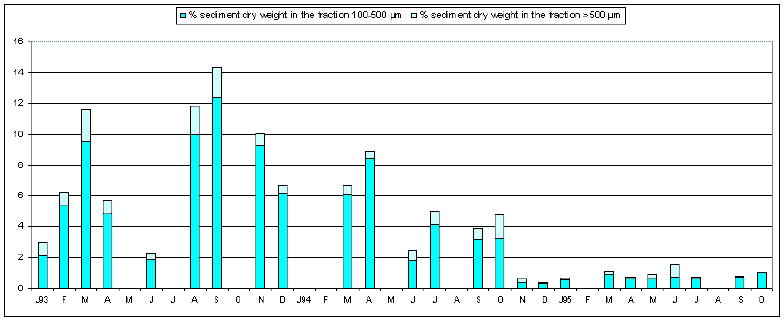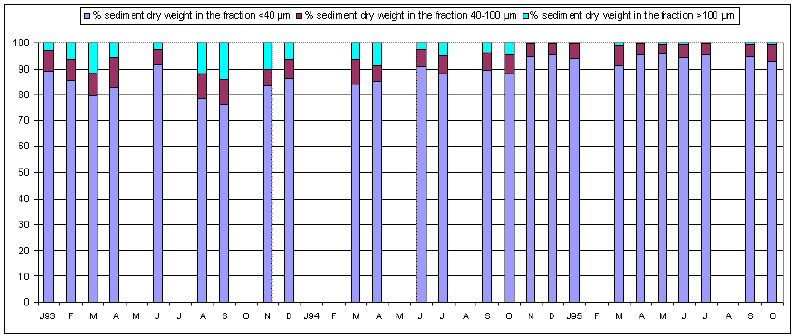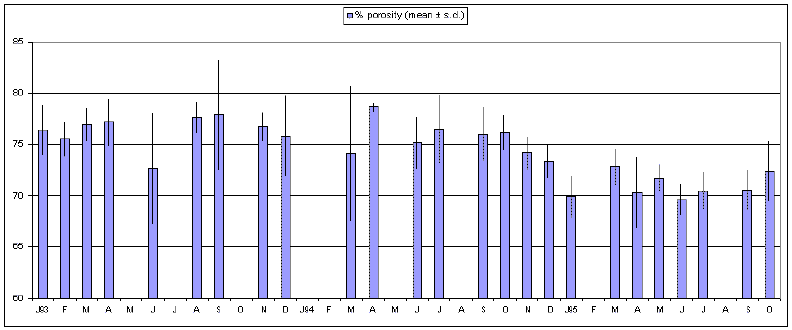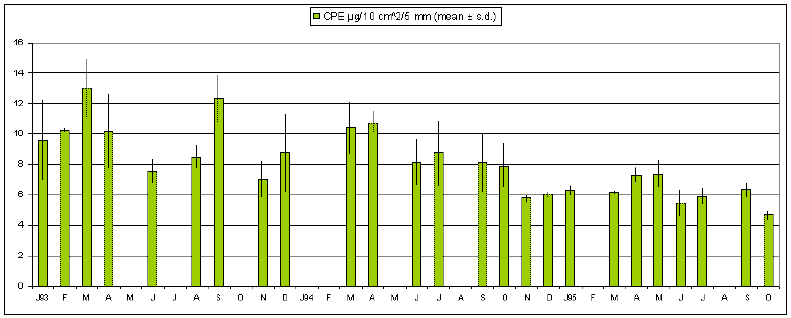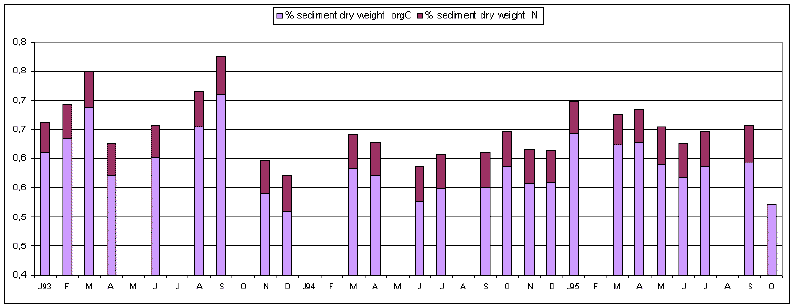|
The
DYFAMED-BENTHOS survey was established at the DYFAMED permanent station in
December 1990 to investigate benthic to pelagic coupling, and
particularly benthic biological (with special emphasis on
metazoan meiofauna) and biogeochemical responses to varying
particulate organic matter inputs to the sea bed.
The
DYFAMED permanent station (43░24'N -7░52'E) in the
northwestern Mediterranean (>2300 m) is relatively close to
land (28 nautical miles off Nice) but presents many of the
characteristics of the open ocean with a strong surface
seasonal signal and essentially vertical particle fluxes. It
is the study site of the on-going French JGOFS DYFAMED
Observation Service, providing comprehensive background water
column data. During the benthic survey that comprised
different phases based on sediment sampling resolution (see
Guidi-Guilvard, 2002), sediment samples were collected monthly
to bimonthly for 5 consecutive years between 1993 and 1997.
Here, are shown data from the first 3 years of the "high
frequency survey" (1993-1995).
MATERIALS
and METHODS
Study
site and sediment sampling
The
DYFAMED coring site is centered around 43░24.61'N - 7░51.67'E
at a depth of 2347 ▒ 6 m, and is located on the side of the
median fan valley of the Var Canyon. Surface sediment was
sampled from January 1993 and to October 1995 first using a SMBA Multiple corer (Barnett et al., 1984), and from November 1993
on, a Bowers and
Connelly Maxicorer (Ocean
Scientific International <http://www.oceanscientific.com>)
which is smaller than the former and thereby more manageable
on small research vessels. Both devices can be equipped with a
set of eight 60-cm long core tubes with an inner diameter of
9.5 and 9.8 cm, respectively. Shipboard positioning was
carried out using DGPS (Differential Global Positioning
System) which can yield horizontal accuracies of 1 to 10 m. In
an attempt to minimise spatial variability, the bottom target
aimed at for coring was a ~200-m diameter circle in which over
80% of the corer casts were achieved. During the 3 years of
survey, 25 benthic cruises were successful in sampling
sediment at an average time interval of 40 days (range = 10 to
99 days). On each cruise, from 1 to 3 corer casts were
achieved, yielding a total of 44 corer casts for the entire
period.
Sample analyses
On
each cruise a basic set of subsamples was obtained from the
sediment cores in order to document both the recent particle
deposit (in the upper 0.5 cm of sediment) and the possible
reactions of the metazoan meiobenthos (in the top 10 cm of
sediment).
Grain size
analyses were performed according to Buchanan (1984) for silty
sediments by wet sieving. Porosity
which provides a measure of interstitial volume, was
calculated according to Giere et al. (1988) after weighing a
known volume of wet and dried (80░ C) washed sediment.
Sediment-bound
chloroplaspic pigments,
which represent a measure of the sedimented primary organic
matter, were
estimated using a Turner Designs fluorometer after extraction
of chlorophyll a and
phaeopigments in 90% acetone (Lorenzen, 1966). Phaeopigments
are expressed as chlorophyll a
equivalents and the sum of both is refered to as chloroplastic
pigment equivalents (CPE). Carbon and nitrogen (N) were
analysed with a Leco
CHN-analyser. The Organic carbon (orgC) fraction was measured
in subsamples treated with 1 M phosphoric acid for removal of
carbonates. Carbonate content (CaCO3) was
calculated as inorganic carbon times 8.33.
Metazoan
meiofauna was subsampled to a
sediment depth of 10 cm using 60-ml cut-off syringes with an
inner cross section area of 6 cm2. Subsamples were
preserved in borate-buffered formaldehyde (4% final
concentration), stained with Rose Bengal and kept at ambient
temperature until subsequent extraction of organisms larger
than 40 Ám using Ludox TM (McIntyre and Warwick, 1984).
After a thorough wash on the sieve, the residue was examined
under an Olympus SZH
stereo microscope (96 x) and the metazoans identified to the
major taxon level.
REFERENCES
Barnett,
P.R.O., Watson, J., Connelly, D., 1984. A multiple corer for
taking virtually undisturbed samples from bathyal and abyssal
sediments. Oceanologica Acta 7, 399-408.
Buchanan, J.B., 1984. Sediment analysis. In:
Holme, N.A., McIntyre, A.D. (Eds), Methods for the study of
marine benthos, Blackwell Scientific Publications, London, pp.
41-65.
Geire,
O., Eleftheriou, A., Murison, D.J., 1988. Abiotic factors. In:
Higgins, R.P., Thiel, H. (Eds.), Introduction to the study of
meiofauna. The Smithsonian Institution Press, Washington D.C.,
pp. 61-78.
Guidi-Guilvard,
L.D., 2002. DYFAMED-BENTHOS, a long time-series benthic survey
at 2347 m depth in the NW Mediterranean: general introduction.
Deep-Sea Research II 49, 2183-2193.
Lorenzen,
C.J., 1966. A method for the continuous measurement of in vivo chlorophyll concentration. Deep-Sea Research I 13, 223-227.
McIntyre,
A.D., Warwick, R.M., 1984. Meiofauna techniques. In: Holme,
N.A., McIntyre, A.D. (Eds), Methods for the study of marine
benthos, Blackwell Scientific Publications, London, pp.
217-244.
|
